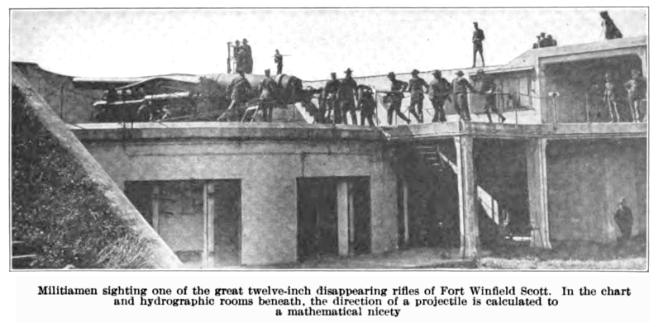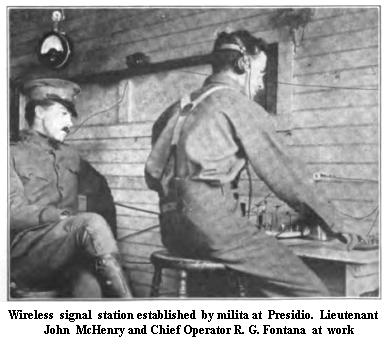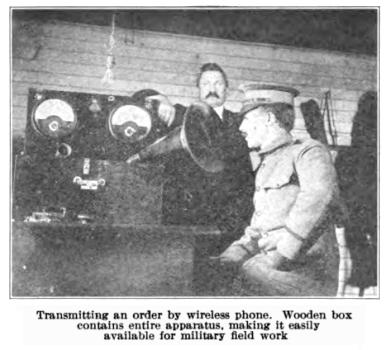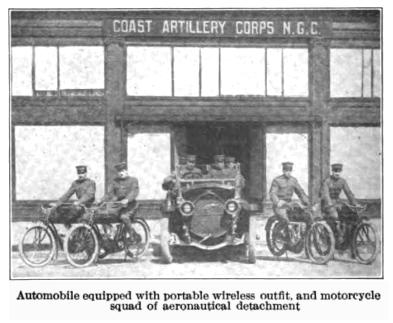According to contempoary accounts, the events reviewed in this article took place in July, 1911.
Sunset Magazine, November, 1911, pages 570-572:
| War as a |
| Modern |
| Science |
| By |
| LOUIS J. STELLMANN |
If the Coast Artillery Corps of the California National Guard were a theatrical organization, a political body or any other sort of institution with a press-agent to exploit its virtues, all the world would know that this branch of the state militia is entitled to international-credit and renown. As it is, comparatively few people realize that the C. A. C., N. G. C., has introduced the wireless telephone as a practical factor into military work, that its members have broken the militia records of the country for sub-caliber and service target practice and that the aeronautical detachment of the C. A. C., etc., is the first subdivision of any army, regular or reserve, devoted to aerial demonstration work in a systematic way.
This same aeronautical detachment deserves a bit of special and prefatory mention as a piece or modern enterprise. It is a product of the combined imagination and executive ability displayed by John McHenry, Jr., whose father and uncle are in the United States service and whose forbears for numerous generations have been military men. Lieutenant McHenry (for he is now a militia subaltern commanding the aeronautical detachment) has, for some time, been greatly interested in all the modern sciences which appertain to military work or are capable of being applied thereto. Aviation, especially, engrossed his attention and, being an intimate friend of Eugene Ely, he discussed his hobby at some length with that aeronaut. Finally he decided to organize an aviation squad of some sort for military work and Ely, an enthusiastic supporter of the scheme, enlisted as the first "private."

McHenry's next step was to consult Colonel George A. Schastey, commander of the Coast Artillery Corps, and, securing his hearty endorsement, to take up the matter of funds for the financing of his proposed detachment. Encountering the usual and formidable red tape which such a venture always meets, McHenry, nothing daunted, started out to get private subscriptions for the expensive equipment needed. He was successful in getting several thousand dollars as a starter and in associating with himself several experienced aviators, including J. C. Handy, George Loose and James Irving. This gave the aeronautical detachment the use of several aeroplanes of the latest military type and the purchase of another, especially constructed, from the Curtiss factory was arranged for.

Then McHenry turned his attention to wireless signaling, and interested Richard G. Fontana, and several more expert young wireless operators. Fontana has just completed a system for communication by wireless telegraph and telephone between aeroplanes and ground stations. This consists of a helmet and jacket similar to the upper portion of a diver's suit. At the right ear of the aviator is placed a minute receiver, while the helmet shuts out the noise of the whirring motor and enables him to transmit messages as well by means of a tiny sending apparatus located over his chest in the unique garment which Fontana has invented and which many believe will work a revolution in aeroplane signals.
The wireless telephone used by the aeronautical detachment is the invention of a San Francisco electrician and is the first instrument of its kind ever used with success in military work. Some time ago a number of warships were equipped with wireless telephones but these were found to be so faulty that they were taken out and further attempts to use them abandoned. Of the San Francisco invention, which is now interesting the government, the aeronautical detachment secured the first set made for sale and tested it thoroughly before using it at the recent Presidio maneuvers.
While encamped in the Presidio, the Coast Artillery Corps had placed at its disposal 36 regular charges and 2,700 sub-caliber charges, of which little more than half was used, owing to foggy weather. But of the twenty service charges fired by the citizen-soldiers, fifteen were registered as hits on the target--a floating ten-foot pyramid coming to a point at the top and towed at a speed of about six miles per hour, five miles out at sea.

Such a militia-gunnery record has never previously been equaled. But this remarkably high grand total is eclipsed as a matter of achievement by the gunners of Company 9, whose first shot shattered the tiny target, passing directly through the center of it, a feat never before approached by militia gunners.
As weather conditions were such as to make aerial demonstration almost suicidal, this feature of the detachment's work had to be abandoned and most of the time during the encampment was devoted to demonstrations of the wireless telephone. As has already been mentioned these demonstrations were the first successful trials of a wireless phone in field work and marked the initial use of such an instrument as practically applied to the furtherance of war games.
It may occur to the reader that the wireless telegraph has been in use for some time as an adjunct to military maneuvers and that the wireless telephone has no easily apparent advantages of important character over the former. Such, however, is far from being the truth. In the first place, the wireless telephone may be used under conditions which would render the wireless telegraph unavailable; it is less influenced by natural obstacles and far less subject to interference by other stations. As this is an accepted electrical fact and as its explanation would be both tedious and unavoidably technical, no attempt at such elucidation will be made here. The important point, to the lay mind, is that the wireless phone can and has been used under conditions which would render the more delicate and complex telegraph useless. There are other advantages, foremost among them the obvious facts that one may talk faster than one can telegraph and that anyone is able to communicate by telephone while it requires a skilled operator to telegraph. For instance, an officer may give his commands directly to the man at the other end--secretly if he so desires--thus eliminating delay and intermediate human agencies which may be unessential if not undesirable. Also, the wireless phone is much harder to "tap" than the telegraph. In fact it requires a more delicate tuning coil than the great majority of telegraph stations possess and is therefore much more private. An effort is now being made to render it absolutely so and, if this is accomplished, the wireless telephone will be the ideal communicatory medium for military operation. It is interesting and mildly amusing to note that one of the first messages sent by the wireless telephone during the Presidio maneuvers was one from Post Commander Colonel Schastey to the captain of the tug Barrett, after the record-breaking hit of Battery Godfrey. It read:

"Is there enough left of target to observe next three shots?"
The answer was an emphatic negative.
Lieut.-Col. H. G. Mathewson, who had active charge of most of the artillery work for the reserves, is enthusiastic in his endorsement of the work of the aeronautical detachment and the value of the wireless phone. He states that but for this body and its equipment not one-quarter of the work accomplished by the Coast Artillery Corps would have been possible.
So heavy was the fog that the tug towing the artillery target could not be seen distinctly enough for wig-wag signals and communication was had solely by wireless telephone. To show how rapidly and smoothly this work might be done an experimental time test was made. A battle commander communicated an order to the wireless operator by means of a field telephone and the wireless operator relayed it to the distant tug, six miles out at sea, by the wireless telephone. It was transcribed by the operator aboard the tug and the repetition "O. K.'d" by the battle commander, all in the space of twenty-three seconds.
During the mimic attack on the port batteries by three tugs posing as a hostile fleet, the invaders were directed by wireless telephone messages while fourteen miles out and responded perfectly. Their failure to run the gauntlet of the searchlights was due to the fact that this is a practical impossibility, since these great paths of light, playing back and forth in a systematic path, can discover any vessel before it gets near enough to damage shore batteries with its fire and can shoot it to pieces with long range cannon.
The land battle between the Blues and Reds--the former being reserves and defending the guns while the latter were regulars and attackers--proved little except that the citizen-soldiers seemed able to hold their own against those who made war their profession. It discovered some fine strategic work and clear, quick thinking on both sides, but it created a situation which as a serious possibility has no existence. No hostile troops could penetrate to the Presidio and menace the big guns with a dangerous land force according to the best known rules for military calculation.
The mines were not used for practice by the reserves this year. It is coming to be believed that harbor mines are generally more dangerous to friend than to foe and the need for their use even as last resource grows less and less with the development of coast defenses. However, the coast artillery reserves will be trained in their use as well as in flying maneuvers as soon as arrangements can be effected. California may reflect with some pride, in the meantime, that her citizens have established a military precedent which will doubtless be followed all over the country and civilized world.




